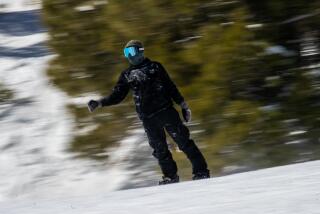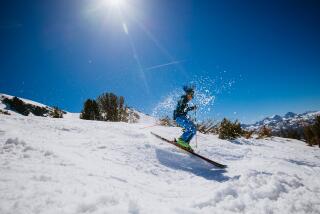At Lake Tahoeâs North Shore, Squaw Valley and Alpine Meadows come together
Squaw Valley USA and Alpine Meadows, two of the largest ski resorts at Lake Tahoe, are combining operations.
If youâre an optimist, the move might get you more downhill runs for your lift-ticket dollar this winter, and it might help the Lake Tahoe/Reno area position itself in the global jostling to host the 2022 Winter Olympics.
If youâre a pessimist, this is the second consolidation among major Tahoe-area resorts in a year, and its effect on the workforce is unclear.
In the deal, announced Tuesday, the two resorts will retain their distinct identities but unite under common management dominated by Squawâs Valleyâs parent company, KSL Capital Partners LLC. Alpine Valleyâs parent, JMA Ventures, will own a smaller part. The new umbrella entity over both resorts will be known as Squaw Valley Ski Holdings LLC.
Together, the resorts amount to more than 6,000 skiable acres, including eight peaks, 44 lifts and more than 270 trails. The two resorts are neighbors but are not connected by any lifts. On Wednesday, Squaw Valley spokeswoman Amelia Richmond said that âthe vision of connecting the two resorts is not lost on the men behind this deal,â including KSL president and chief executive Andy Wirth, who will lead the merged companies.
But in the short term, Richmond said, âWith the ski season fast approaching, our priority now is to make sure this is a seamless transition.â
A third neighbor to the two is the much smaller White Wolf resort. Its owner, Troy Caldwell, told the San Francisco Chronicle this in March 2008: âIf my dream were totally brought to fruition, White Wolf Mountain would become an inter-connect between Alpine and Squaw. A skier could ski from the Squaw side all the way to the Alpine Meadows ski area.â
The Squaw Valley-Alpine Meadows consolidation will probably be finalized in late October or early November, Richmond said. Meanwhile, the resortsâ websites are already selling a new Tahoe Super Pass, which allows unlimited skiing and riding at both resorts for $799 (adults age 23 to 64) or $529 (ages 13 to 22 and 65 to 75). For $439, adult skiers and boarders can get a Bronze Super Pass that covers most of the season, with about 15 high-demand days blacked out.
For a Tahoe Super Six pass, which allows six unrestricted days of skiing and riding, the adult price is $399.
For skiers who had already purchased season passes at one of the resorts, the move could be a bonus â many will now have access to much more snow for the same price. Squaw management has set up an FAQ page to clarify what will change and what wonât.
The new passes do not include Homewood Mountain or Kirkwood resorts. Homewood Mountain Resort, which has operated as a sibling resort to Alpine Meadows, will not be affected by the new affiliation and will continue to be owned and operated by JMA.
The last year has brought a rush to consolidate among ski resorts in the area. Vail Resorts Inc., operator of Heavenly Mountain Resort in South Lake Tahoe, in October 2010, also acquired the Northstar-at-Tahoe resort near the lakeâs North Shore.
Squaw Valley, on Lake Tahoeâs North Shore, includes six mountain peaks, 30 lifts and more than 3,600 skiable acres. Its trails are 45% intermediate, 30% advanced and 25% beginner. It hosted the 1960 Winter Olympics and has been mentioned as a possible contender to host the 2022 winter games.
KSL, based in Denver, bought Squaw Valley late last year. In July, it kicked off a $50-million, multi-year upgrade, known as âSquaw Renaissance.â Once management has further considered possibilities for the 2,400 skiable acres and 100 trails at Alpine Meadows, Richmond said, âsimilar significant investments will be made there are well.â
Streamlining workforces is typically a goal in a merger, if only at the executive level. But Squaw Valley officials declined to discuss any details. âThis deal wonât be closed for a couple of months,â Richmond said, âso anything regarding employees is premature to discuss until closing.â
Squaw Valleyâs workforce amounted to about 1,700 people at the peak of last winter, Richmond said.
As for the moveâs Olympic implications, the Colorado Independent on Wednesday suggested that the Reno-Lake Tahoe region âsuddenly became a lot more attractive.â With their territories merged, the Independent noted, Squaw Valley and Alpine Meadows are larger than Vail, Colo. The International Olympic Committee isnât expected to choose a 2022 location until 2015.
More to Read
Sign up for The Wild
Weâll help you find the best places to hike, bike and run, as well as the perfect silent spots for meditation and yoga.
You may occasionally receive promotional content from the Los Angeles Times.







